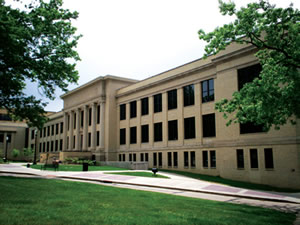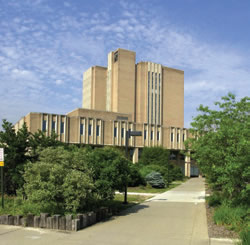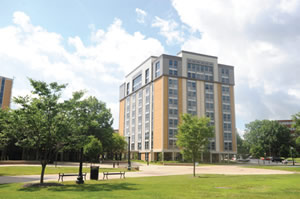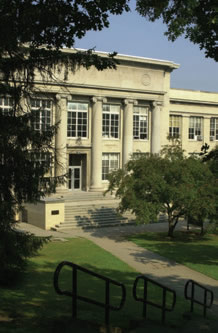Sealing the Envelope

PHOTOS COURTESY OF KENT STATE UNIVERSITY
The process of renovating and constructing tight, efficient building envelopes — everything that keeps the outside out, such as roofs, walls, windows and more — is becoming more complex and exacting, and with increasingly sophisticated materials and techniques to match.
Recent work across the campus of Ohio’s Kent State University is telling of the range of solutions in new construction and renovation projects — and the kinds of challenges driving their applications — on campuses today. College Planning & Management recently visited Kent State for a look with campus architect Vincent Putaturo, who described a number of projects that have included envelopes on a diverse palette of building styles, sizes and types.
Among the recent Kent State initiatives: a comprehensive energy conservation renovation initiative completed in 2014 across 26 residence halls, a number of which had their windows replaced, their exteriors caulked and tuckpointed, and their lintels repaired or replaced. The university is already noting significant energy savings.

PHOTOS COURTESY OF KENT STATE UNIVERSITY
Updates and Improvements
In one instance of a major renovation, the university’s Tri-Towers student residence halls, which were nondescript, high-rise buildings with an institutional look, received new exteriors. Putaturo explains that exterior metal panels and new operable windows were installed, boosting efficiency while giving a more sleek and attractive look to the buildings’ façades. In other work, the university describes a project by URS Corporation and Terik Roofing that replaced the roofs and windows of Kent State’s 12-story library (lower right, page 41). One challenge there, according to Putaturo: staging the removal and placement of materials on the library’s high, small roof spaces.
Some blocks away, workers were installing an air barrier to Kent State’s newly constructed Institutional Advancement Building, where sheathing and some metal studs were visible and work to walls and the roof was underway. Putaturo explains that the new exterior wall system’s rigid and membrane materials, including a single-ply TPO (thermoplastic polyolefin), will help the building meet its targeted LEED Silver certification, which is the campus standard. In another approach, Kent State has used an outsulation system — an energy-efficient cladding for exteriors — in some projects on regional campuses.

PHOTOS COURTESY OF KENT STATE UNIVERSITY
I LIKE WHAT YOU’VE DONE WITH THE PLACE. As part of the “Foundations of Excellence: Building the Future” initiative, which involves the construction of new buildings and a number of facility upgrades across campus, Ohio’s Kent State University renovated its Tri-Towers student residence halls. The facilities have new roofs, windows, carpet and paint, as well as new metal paneling on the exterior of the buildings. The improvements are not just for show; the buildings are expected to be more energy-efficient and provide improved interior comfort for residents. When renovating existing facilities, it’s important to research current methods and materials for improving exteriors and save money in the long run.
Putaturo has been working on projects at Kent State for 16 years, and has seen various changes in envelope materials during that time, from coal-tar roofs to, as mentioned, outsulation and single-ply TPO systems with long warranties, in the evolving effort to raise the bar for energy efficiency and thermal ratings in walls and roofs.
Changing Codes, Changing Materials, Changing Designs
It reflects changes elsewhere. Codes have gotten more stringent, of course, drawing more and more design aspects into the discussion about energy impact. In fact, “I’d say there’s been a dramatic change,” says Wyck Knox of VMDO Architects, a firm that has worked on varied projects with highly efficient building envelope designs, such as campus centers for Young Harris College in Georgia and Stockton University in New Jersey, residence halls at Georgia Tech, and a sports practice facility at Virginia Commonwealth University.
“The conversation has changed,” says Knox, all the way from a building’s site orientation and massing to roofs to percentage of glazing to “all the way down to the smallest things.” As VMDO points out, studies have shown that taking specific steps in projects, such as tight building envelopes, boost efficiency and conserve energy and “generate the fastest Return on Investment.”
In another instance on another campus, a high-performance envelope was one of the key elements that enabled planners at Case Western Reserve University in Cleveland to develop a new University Center as it had been envisioned. Designed by Perkins+Will and opened in 2014, the building was to have an expansive, open view from the building onto green space and toward a developing section of campus to the west. Solar radiation, as well as severe winters, presented challenges to having an immense glass wall on that side of the facility. There was a solution, however: a double glass-pane curtain wall with a high thermal rating, an air space between the panes of glass equipped with fans to cool that space, and an automated system of screens triggered into action with photo sensors.

PHOTOS COURTESY OF KENT STATE UNIVERSITY
Back at Kent State, additional recent projects indicate the demands of renovating envelopes of diverse building types. For example, work in 2013 restored the roof and brick and stone facades of McGilvrey Hall, a stout, 77-year-old building where water had penetrated and damaged its masonry and steel exterior, leading to a cycle of more moisture and freeze-thaw damage, according to consulting engineers Carl Walker, Inc. The plan of action, the company explains, included installing components such as stainless-steel flashing and anchors, and silicone sealants to block water penetration into the façade while preserving the building’s regal look.
Finally, another recent envelope-related project on campus turned out to be not so routine. Franklin Hall, another grand building, seen here and on page 41, top, was undergoing roofing renovations. A storm swept through the region on a weekend, and a deteriorated section of Franklin’s roof parapet toppled to the ground. There were no injuries, and workers rebuilt the parapet.
That instance aside, work involving new building envelopes can be customary. It’s also essential; especially as efficiency standards and costs rise, meaning that investing wisely can yield results that are anything but humdrum. The effort is worth it. After all, as Putaturo adds, “Our buildings are built to be here for quite a long time.”
SOME IDEAS ABOUT BUILDING ENVELOPES
- Understand the details of the entire process, from design to construction.
- Keep quality in the forefront. Of course, budgetary constraints, upfront vs. life-cycle costs, timetables and other factors all have to be part of the equation, but so are performance and longevity.
- Request mockups from contractors; for example, on masonry, window and flashing installations, suggests Putaturo. He explains they are used increasingly on his campus, where “mockups get inspected and approved before proceeding with the rest of the building.”
- Be vigilant about proposed substitutions. Contractors, for various reasons, will ask to switch products. Listen to and evaluate their requests, but strike a balance. ”You need to maintain the original integrity of what you were trying to achieve,” Putaturo says. If the proposed substitution and the level of resulting quality meet those criteria, consider going with it.
This article originally appeared in the issue of .